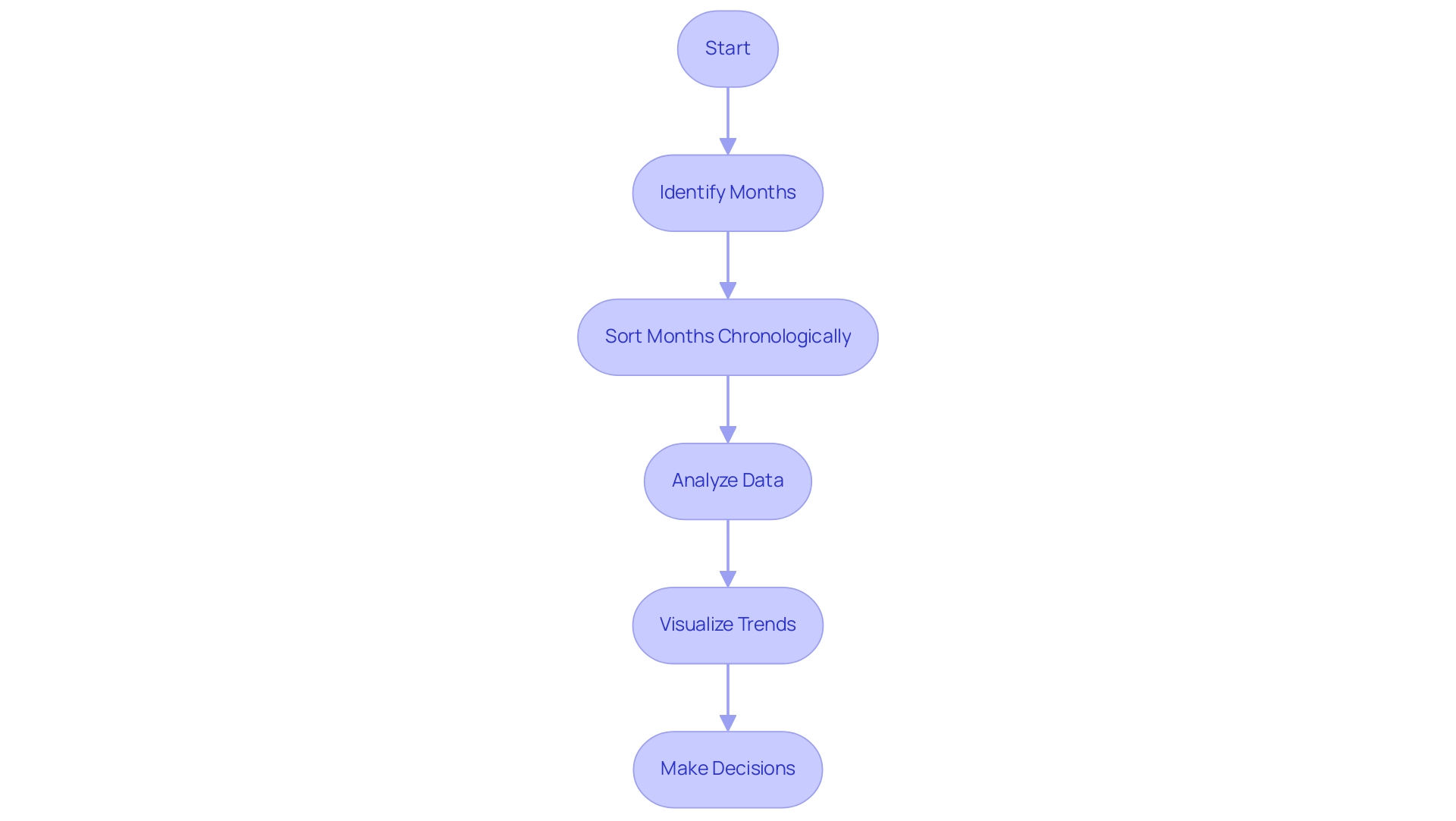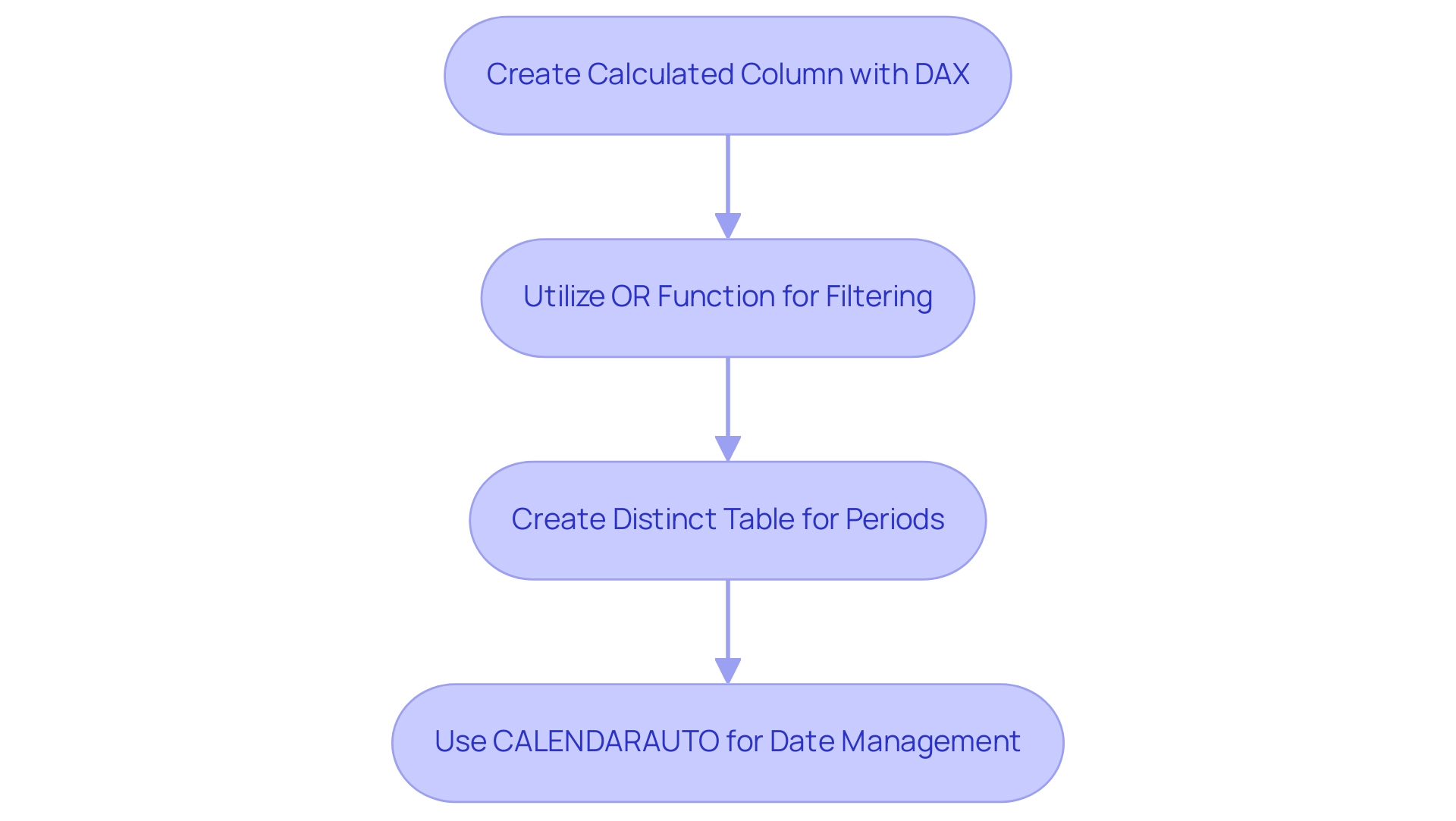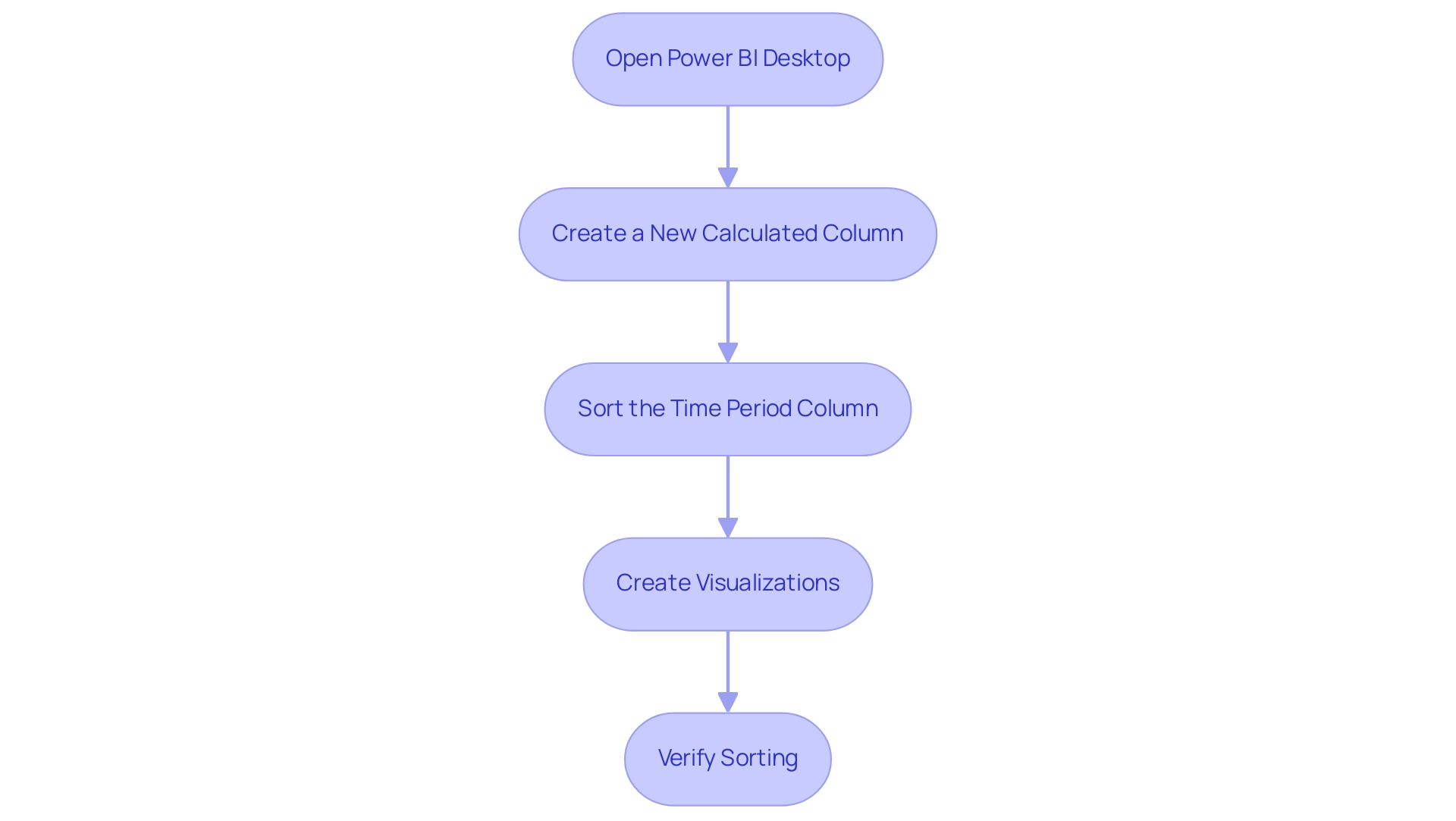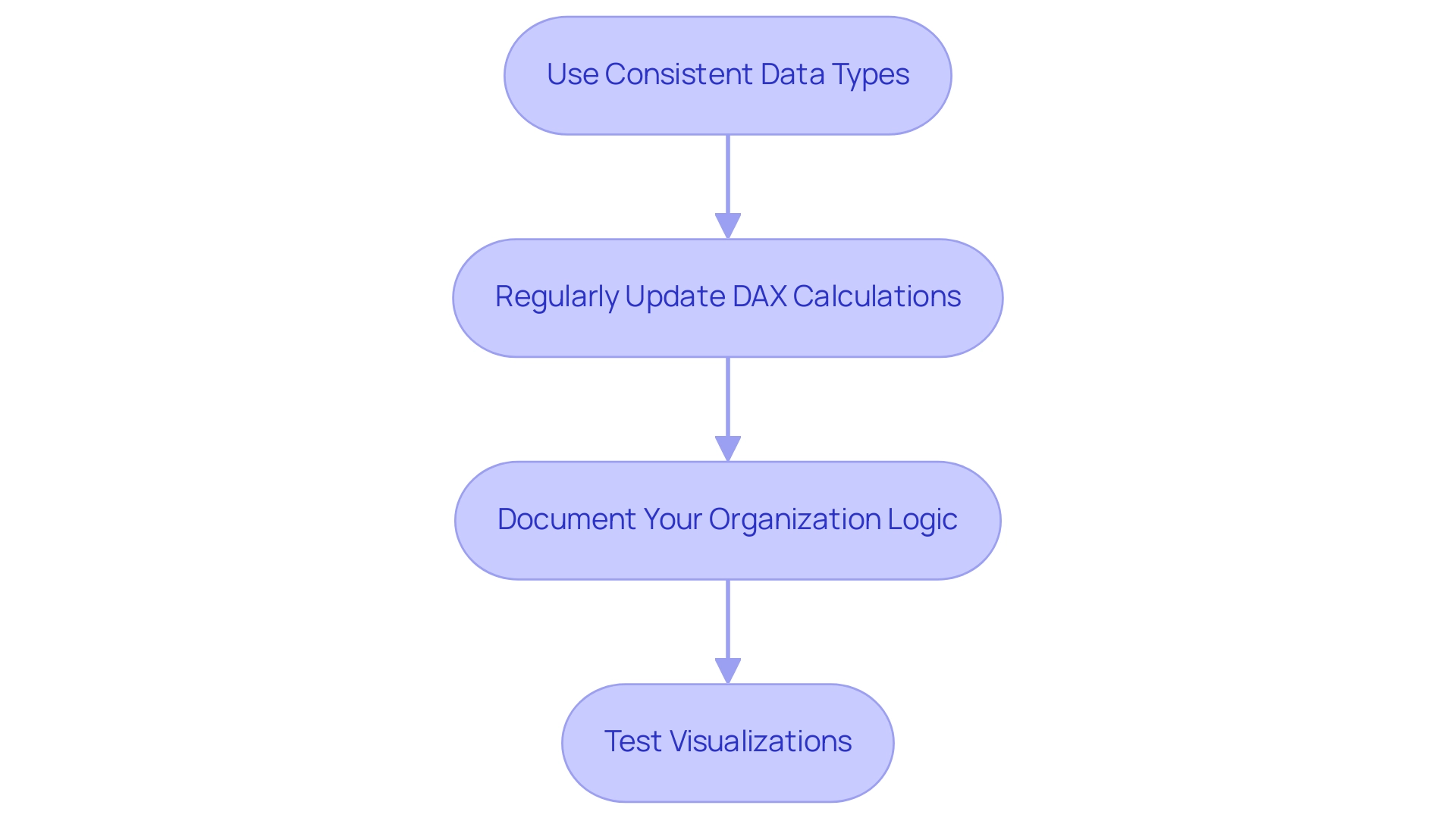Overview
To effectively sort months in order within Power BI, users should utilize techniques such as creating a calculated column with DAX that assigns numerical values to each month, ensuring a logical chronological sequence in reports. The article emphasizes that proper month sorting is crucial for accurate time series analysis, as incorrect sorting can lead to confusion and hinder decision-making, thereby highlighting the importance of consistent data types and best practices in report creation.
Introduction
In the realm of data analysis, the ability to sort months chronologically in Power BI is not merely a technical detail; it is a cornerstone of effective reporting and decision-making. Many users encounter the frustrating challenge of default alphabetical sorting, which muddles insights and obscures trends.
This article delves into the significance of proper month sorting, exploring common pitfalls, innovative DAX techniques, and best practices that empower users to harness the full potential of their data. By mastering these sorting methods, organizations can transform their data visualizations, enabling clearer insights and fostering a culture of informed decision-making that drives operational success.
Understanding the Importance of Month Sorting in Power BI
In this tool, it is essential to use Power BI to sort months in order for obtaining precise time series analysis. Wrong sorting techniques, such as not using Power BI to sort months in order and instead organizing periods alphabetically (e.g., April, August, December), can result in considerable confusion and mistrust in the information, ultimately hindering the capacity to derive actionable insights from it. This misrepresentation is especially problematic considering the common challenges many encounter with Power BI, such as time-consuming report creation and inconsistencies.
For instance, when using Power BI to sort months in order while examining sales information, displaying periods in their proper chronological sequence allows users to efficiently perceive trends and patterns over time. This alignment not only enhances understanding but also supports informed decision-making, addressing the pitfalls of report creation that often distract from leveraging insights. As Kelly Lautt observed, combining Business Intelligence with effective information presentation is crucial for generating insights, particularly in how Power BI can sort months in order.
Moreover, research indicates that visual representation can lessen cognitive load and enhance recall in comparison to text, emphasizing this categorization method’s essential function in Power BI, especially when using Power BI to sort months in order. The objectives of the Data Presentation Architecture emphasize delivering relevant and actionable information that minimizes complexity and ensures clarity for different audiences. Furthermore, establishing a strong governance strategy is crucial to uphold information consistency and reduce confusion stemming from ineffective categorization practices.
Therefore, mastering time organization methods in Power BI to sort months in order is crucial for developing effective visualizations that convey the correct insights clearly and enhance operational efficiency.

Common Challenges in Sorting Months in Power BI
One common problem faced by Power BI users is that they need to find a way to power BI sort months in order instead of having them arranged alphabetically, which can greatly impede analysis efficiency. This misalignment frequently occurs when the monthly information type is improperly set up, resulting in confusion and wasted time—issues that could be alleviated through the adoption of Robotic Process Automation (RPA) to optimize workflows. In fact, many of the 202 top kudoed authors report facing similar challenges that arise when attempting to power bi sort months in order, particularly when months are represented as text rather than recognized date values, complicating the arrangement process.
Furthermore, misconfigured connections between tables can hinder appropriate arrangement, leading to flawed information representation, which reduces the effectiveness of Business Intelligence tools. For instance, in the case study ‘Searching Documents in Elasticsearch,’ users faced similar sorting challenges that impacted their retrieval processes. Addressing these issues also requires a robust governance strategy to ensure consistency and reliability across reports.
Furthermore, customized AI solutions can be instrumental in navigating these challenges, providing users with the necessary tools to enhance their analytical capabilities. Understanding these obstacles is crucial, as it paves the way for tailored solutions that can cut through the noise of the rapidly evolving AI landscape, ensuring that stakeholders are equipped with actionable insights for informed decision-making. As one user aptly noted,
That did it, thank you!
illustrating the critical importance of addressing these common challenges to enhance the overall information analysis experience.

Methods for Sorting Months: DAX and Custom Techniques
To improve visualization in Power BI, it is essential to use techniques that can help you Power BI sort months in order efficiently. One of the most effective techniques involves utilizing Data Analysis Expressions (DAX) to create a calculated column that assigns a numerical value to each month—January as 1, February as 2, and so on. This numerical representation enables users to organize their information according to this column, which supports how Power BI sort months in order, ensuring a logical chronological order in reports.
This is particularly crucial in today’s data-rich environment where the ability to extract meaningful insights can determine a business’s competitive edge, making the role of Business Intelligence indispensable. Additionally, the OR function in DAX can be utilized in conjunction with these techniques to create more complex filtering and arrangement conditions, enhancing the analytical capabilities of the reports.
Additionally, another robust personalized arrangement method entails creating a distinct table that enumerates the periods in the preferred sequence and connecting it to the primary information table. This approach not only offers adaptability in scheduling but also improves the clarity of the visual representations. A significant example in this domain is the use of the CALENDARAUTO function, which automatically recalibrates date table parameters, ensuring that the month arrangement stays up-to-date with the model after each refresh.
This function’s capability to keep the information model updated is essential for maintaining precise and prompt analysis, particularly in tackling challenges like inconsistencies and time-consuming report creation.
Denys Arkharov, a BI Engineer at Coupler.io, emphasizes the significance of such techniques, stating, “A notable achievement in my career was my involvement in creating Risk Indicators for Ukraine’s ProZorro platform, a project that led to my work being incorporated into the Ukrainian Law on Public Procurement.” This emphasizes the real-world effect of effective DAX methods and custom arrangement techniques in visual representation, underpinning the vital role of RPA solutions like EMMA RPA and Automation streamlining operations and enhancing employee morale. EMMA RPA can automate repetitive information entry tasks, while Automate can facilitate the integration of BI with other applications, further enhancing efficiency.
These DAX methods and custom sorting techniques not only streamline the sorting process but also enable Power BI to sort months in order, contributing to more effective analysis and visualization, which allows for clearer insights and improved decision-making, critical for driving growth and innovation in any organization.

Step-by-Step Guide to Sorting Months in Power BI
- Open Power BI Desktop and load your information model to begin the process. In today’s data-rich environment, optimizing your reporting capabilities is crucial for informed decision-making.
- Create a New Calculated Column: Navigate to the data view, select your date table, and create a new column with the DAX formula:
Month Number = MONTH([Date]). This step is critical as it allows you to assign a numerical value to each period, which is essential to power BI sort months in order and facilitate accurate sorting. - Sort the Time Period Column: Select your designated time period column (e.g., ‘MonthName’). Go to the ‘Modeling’ tab, click on ‘Sort by Column,’ and choose the newly created ‘MonthNumber’ column. This action ensures that the names align correctly with their numerical order when you use Power BI to sort months in order.
- Create Visualizations: Incorporate your month column into visualizations. With the power bi sort months in order applied, your information should now display in the correct chronological order, enhancing clarity and insight. This structured approach not only simplifies report creation but also addresses common challenges such as data inconsistencies and task repetition, which can be mitigated by integrating RPA solutions.
- Verify Sorting: Thoroughly check your reports to confirm that months appear in chronological order. If discrepancies arise, revisit the setup of your calculated column and the sorting options to ensure you can effectively use Power BI to sort months in order. This attention to detail is crucial, as highlighted by community discussions on effective practices in Business Intelligence.
Furthermore, once the CSV file of audit logs is generated, it can be used as a source in BI, providing additional insights into your information. As Brian, an Enterprise DNA Expert, aptly states,
Thanks for the feedback – always wonderful to hear folks getting great value out of their memberships,
underscoring the importance of proper information management practices in driving operational efficiency and the potential of RPA to enhance these processes.

Best Practices for Effective Month Sorting in Power BI
To ensure effective arrangement of periods in Power BI, it is crucial to adopt the following best practices:
- Use Consistent Data Types: To avoid organization issues, ensure that your period and date columns are formatted as date types. Uniformity in information types is crucial, as it directly affects how Power BI sorts months in order with precision. For example, if a period is regarded as text, it may not allow Power BI to sort months in order accurately, resulting in deceptive visual representations that could obstruct business intelligence initiatives.
- Regularly Update DAX Calculations: It is crucial to revisit your DAX calculations whenever there are modifications in your information model. Updating these calculations guarantees that your reports stay precise and representative of the most current information, in line with the operational efficiency objectives of your organization.
- Document Your Organization Logic: Keeping thorough records of your organization logic is advantageous for future reference or for team members who might assume responsibility for the report. This practice not only supports continuity but also improves collaboration and understanding among team members, tackling potential challenges in utilizing insights effectively.
- Test Visualizations: Before finalizing reports, always confirm that your visualizations accurately represent the intended sequence. This proactive method aids in recognizing and correcting any inconsistencies early in the process, ensuring that your dashboards can use Power BI to sort months in order for actionable insights.
Integrating these practices not only simplifies the monthly organization process but also conforms to the recommendations of visualization specialists like Mateusz Mossakowski, who stated,
What we really need is to stick to a numeric measure and ‘push’ the formatting piece to where it belongs — meaning to a dynamic format string.
This perspective highlights the importance of suitable information management in achieving effective visualizations that drive growth and innovation. Additionally, another custom arrangement technique involves organizing segments in a bar chart based on categories that are not directly represented in the chart.
By including the category field in tooltips and arranging by the first category, users can efficiently classify segments into their corresponding categories, enhancing information visualization.
Moreover, Amir Netz remarked,
The rise and history of BI,
emphasizing the continuous evolution of the platform and its functionalities. This underscores the significance of remaining current with best practices and innovative techniques in Power BI to tackle the challenges of time-consuming report creation and inconsistencies. Moreover, integrating Robotic Process Automation (RPA) into your reporting processes can significantly enhance operational efficiency.
By automating repetitive tasks associated with data management and report generation, RPA can help mitigate the competitive disadvantages faced by businesses that struggle to extract actionable insights from their data.

Conclusion
Mastering the art of sorting months chronologically in Power BI is not just a technical necessity; it is a vital component of effective data analysis and decision-making. The exploration of various sorting methods, including DAX techniques and custom approaches, highlights the importance of presenting data accurately to uncover meaningful insights. By addressing common challenges, such as default alphabetical sorting and misconfigured relationships, users can enhance the clarity and reliability of their reports.
Implementing best practices, such as maintaining consistent data types and regularly updating calculations, ensures that visualizations reflect the intended chronological order. This attention to detail not only simplifies the report creation process but also fosters a culture of informed decision-making within organizations. The integration of Robotic Process Automation (RPA) further streamlines operations, allowing teams to focus on deriving actionable insights rather than getting bogged down by repetitive tasks.
Ultimately, the ability to sort months correctly in Power BI empowers organizations to transform their data visualizations, turning raw data into clear narratives that drive operational success. Embracing these techniques and best practices is essential for anyone looking to leverage the full potential of Power BI and foster a data-driven culture that leads to enhanced performance and innovation.

